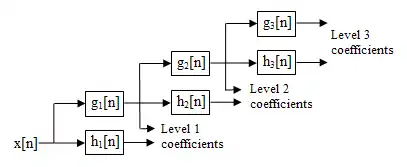Stationary wavelet transform
The Stationary wavelet transform (SWT)[1] is a wavelet transform algorithm designed to overcome the lack of translation-invariance of the discrete wavelet transform (DWT). Translation-invariance is achieved by removing the downsamplers and upsamplers in the DWT and upsampling the filter coefficients by a factor of in the th level of the algorithm.[2][3][4][5] The SWT is an inherently redundant scheme as the output of each level of SWT contains the same number of samples as the input – so for a decomposition of N levels there is a redundancy of N in the wavelet coefficients. This algorithm is more famously known as "algorithme à trous" in French (word trous means holes in English) which refers to inserting zeros in the filters. It was introduced by Holschneider et al.[6]
Implementation
The following block diagram depicts the digital implementation of SWT.

In the above diagram, filters in each level are up-sampled versions of the previous (see figure below).

KIT
Applications
A few applications of SWT are specified below.
Synonyms
- Redundant wavelet transform
- Algorithme à trous
- Quasi-continuous wavelet transform
- Translation invariant wavelet transform
- Shift invariant wavelet transform
- Cycle spinning
- Maximal overlap wavelet transform (MODWT)
- Undecimated wavelet transform (UWT)
See also
- wavelet transform
- wavelet entropy
- wavelet packet decomposition
References
- James E. Fowler: The Redundant Discrete Wavelet Transform and Additive Noise, contains an overview of different names for this transform.
- A.N. Akansu and Y. Liu, On Signal Decomposition Techniques, Optical Engineering, pp. 912-920, July 1991.
- M.J. Shensa, The Discrete Wavelet Transform: Wedding the A Trous and Mallat Algorithms, IEEE Transactions on Signal Processing, Vol 40, No 10, Oct. 1992.
- M.V. Tazebay and A.N. Akansu, Progressive Optimality in Hierarchical Filter Banks, Proc. IEEE International Conference on Image Processing (ICIP), Vol 1, pp. 825-829, Nov. 1994.
- M.V. Tazebay and A.N. Akansu, Adaptive Subband Transforms in Time-Frequency Excisers for DSSS Communications Systems , IEEE Transactions on Signal Processing, Vol 43, No 11, pp. 2776-2782, Nov. 1995.
- M. Holschneider, R. Kronland-Martinet, J. Morlet and P. Tchamitchian. A real-time algorithm for signal analysis with the help of the wavelet transform. In Wavelets, Time-Frequency Methods and Phase Space, pp. 289–297. Springer-Verlag, 1989.
- Zhang, Y. (2010). "Feature Extraction of Brain MRI by Stationary Wavelet Transform and its Applications". Journal of Biological Systems. 18 (s1): 115–132. doi:10.1142/S0218339010003652.
- Dong, Z. (2015). "Magnetic Resonance Brain Image Classification via Stationary Wavelet Transform and Generalized Eigenvalue Proximal Support Vector Machine". Journal of Medical Imaging and Health Informatics. 5 (7): 1395–1403. doi:10.1166/jmihi.2015.1542.